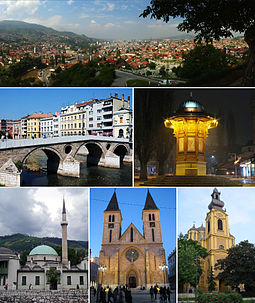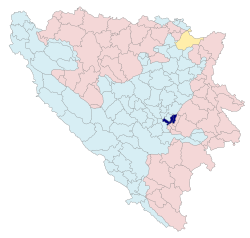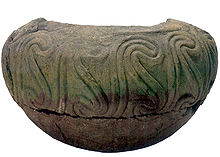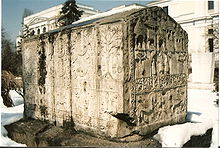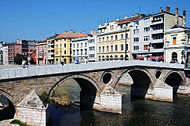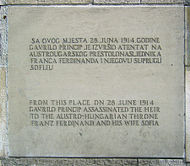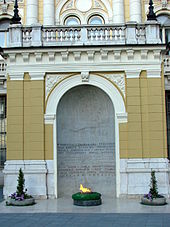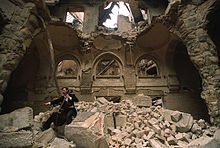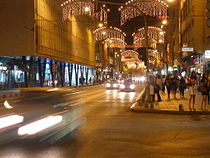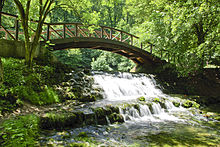
Sarajevo
Background to the schools Wikipedia
SOS Children, an education charity, organised this selection. A quick link for child sponsorship is http://www.sponsor-a-child.org.uk/
| Sarajevo | |||
|---|---|---|---|
| — City — | |||
| City of Sarajevo Grad Sarajevo |
|||
| Top: Downtown Sarajevo; Middle: Latin Bridge (left), Sebilj (right); Bottom: Emperor's Mosque (left), Cathedral of Jesus' Heart (centre), Serb Orthodox Cathedral (right) | |||
|
|||
| Nickname(s): Jerusalem of Europe, Jerusalem of the Balkans, Rajvosa (local Pig Latin) | |||
| Bosnia and Herzegovina surrounding Sarajevo (dark blue, centre) | |||
| Coordinates: 43°52′0″N 18°25′0″E | |||
| Country | |||
| Entity | Federation of Bosnia and Herzegovina | ||
| Canton | |||
| Municipalities | 4 | ||
| Government | |||
| • Mayor | Dr. Ivo Komšić ( SDU) | ||
| Area | |||
| • Urban | 141.5 km2 (54.6 sq mi) | ||
| Elevation | 518 m (1,699 ft) | ||
| Population (31 August 2011) | |||
| • City | 321,000 | ||
| • Density | 2,263.5/km2 (5,862/sq mi) | ||
| • Urban | 469,400 | ||
| • Metro | 669,000 | ||
| • Demonym | Sarajevan | ||
| Time zone | CET ( UTC+1) | ||
| • Summer ( DST) | CEST ( UTC+2) | ||
| Postal code | 71000 | ||
| Area code(s) | +387 (33) | ||
| Twin cities | |||
| • Barcelona | |||
| • Zagreb | |||
| • Ljubljana | |||
| • Salt Lake City | |||
| • Cairo | |||
| • Dubrovnik | |||
| • Skopje | |||
| • Lillehammer | |||
| • Pula | |||
| Website | City of Sarajevo | ||
Sarajevo ( Cyrillic: Сарајево) (pronounced [sǎrajɛʋɔ]) is the capital and largest city of Bosnia and Herzegovina, with an estimated population of over 321,000 people within its administrative limits. It is also the capital of the Federation of Bosnia and Herzegovina entity, as well as the centre of the Sarajevo Canton, which has estimated population of 469,400. Nestled within the greater Sarajevo valley of Bosnia, it is surrounded by the Dinaric Alps and situated along the Miljacka River in the heart of Southeastern Europe and the Balkans.
Sarajevo is the leading political, social and cultural center of Bosnia and Herzegovina, and its region-wide influence in politics, education, entertainment, media, fashion, science, and the arts contribute to its status as Bosnia and Herzegovina's major economic centre.
The city is historically famous for its traditional cultural and religious diversity, with adherents of Islam, Orthodoxy, Catholicism and Judaism coexisting there for centuries. Due to this long and rich history of religious and cultural variety, Sarajevo is often called the "Jerusalem of Europe" or "Jerusalem of the Balkans". It was, until recently in the 20th century, the only major European city to have a mosque, Catholic church, Orthodox church and synagogue within the same neighbourhood.
Although settlement in the area stretches back to prehistoric times, the modern city arose as an Ottoman stronghold in the 15th century. Sarajevo has attracted international attention several times throughout its history. In 1885, Sarajevo was the first city in Europe and the second city in the world to have a full-time electric tram network running through the city, the first being San Francisco. In 1914, it was the site of the assassination of the Archduke of Austria that sparked World War I. Seventy years later, it hosted the 1984 Winter Olympics. For nearly four years, from 1992 to 1996, the city suffered the longest siege of a city in the history of modern warfare during the Bosnian War for independence.
Sarajevo has been undergoing post-war reconstruction, and is the fastest growing city in Bosnia and Herzegovina. The travel guide series, Lonely Planet, has named Sarajevo as the 43rd best city in the world, and in December 2009 listed Sarajevo as one of the top ten cities to visit in 2010. In March 2012, Sarajevo won travel blog Foxnomad's "Best City to Visit" competition, beating out more than one hundred cities around the entire world. In 2011, Sarajevo was nominated to be the European Capital of Culture in 2014 and will be hosting the European Youth Olympic Festival in 2017.
Etymology
The earliest known name for the region of today's Sarajevo is Vrhbosna.
Sarajevo is a slavicized word based on saray, the Turkish word for the governor's palace. The letter Y does not exist in the Bosnian version of the Latin alphabet. The "evo" portion may come from the term Saray Ovası first recorded in 1455, meaning "the plains around the palace". However, in his Dictionary of Turkish loanwords, Abdulah Škaljić maintains that the "evo" ending is more likely to have come from Slavic ending "evo", found in many other Slavic place names, such as Mukachevo, Kraljevo, Kičevo, etc., than from the Turkish ending "ova", as proposed by some.
Sarajevo has had many nicknames. The earliest is Šeher, which is the term Isa-Beg Ishaković used to describe the town he was going to build. It is a Turkish word meaning an advanced city of key importance (şehir) which in turn comes from Persian شهر shahr (city). As Sarajevo developed, numerous nicknames came from comparisons to other cities in the Islamic world, i.e. "Damascus of the North". The most popular of these was "European Jerusalem".
Some argue that a more correct translation of saray is government office or house. Saray is a common word in Turkish for a palace or mansion; a fortified government office, or house, would still be called a saray, if it maintained the general look of an office. Otherwise it would be called kale (castle).
History
Ancient times
Archaeologists have found that the Sarajevo region has been continuously inhabited by humans since the Neolithic age. The most famous example of a Neolithic settlement in the Sarajevo area is that of the Butmir culture. The discoveries at Butmir were made on the grounds of the modern-day Sarajevo suburb Ilidža in 1893 by Austro-Hungarian authorities during the construction of an agricultural school. The area’s richness in flint was no doubt attractive to Neolithic man, and the settlement appears to have flourished. The settlement developed unique ceramics and pottery designs, which characterize the Butmir people as a unique culture. This was largely responsible for the International congress of archaeologists and anthropologists meeting in Sarajevo in 1894.
The next prominent culture in Sarajevo were the Illyrians. The ancient people, who considered most of the West Balkans as their homeland, had several key settlements in the region, mostly around the river Miljacka and Sarajevo valley. The Illyrians in the Sarajevo region belonged to the Daesitiates, a war-like people who were probably the last Illyrian people in Bosnia and Herzegovina to resist Roman occupation. Their defeat by the Roman emperor Tiberius in 9 A.D. marks the start of Roman rule in the region. The Romans never built up the region of modern-day Bosnia very much, but the Roman colony of Aquae Sulphurae was located near the top of present-day Ilidža, and was the most important settlement of the time. After the Romans, the Goths settled the area, followed by the Slavs in the 7th century.
Middle Ages
During the Middle Ages Sarajevo was part of the Bosnian province of Vrhbosna near the traditional centre of the Bosnian kingdom. Though a city called Vrhbosna existed, the exact settlement of Sarajevo at this time is debated. Various documents of the high Middle Ages note a place called Tornik in the region. By all indications, Tornik was a very small marketplace surrounded by a proportionally small village, and was not considered very important by Ragusan merchants.
Other scholars say that Vrhbosna was a major city located at the site of modern-day Sarajevo. Papal documents say that in 1238, a cathedral dedicated to Saint Paul was built in the city. Disciples of the notable saints Cyril and Methodius stopped by the region, founding a church at Vrelobosna. Whether or not the city was located at modern-day Sarajevo, the documents attest to its and the region's importance. Vrhbosna was a Slavic citadel from 1263 until it was occupied by the Ottoman Empire in 1429.
Ottoman era

Sarajevo was founded by the Ottoman Empire in the 1450s upon its conquest of the region, with 1461 used as the city’s founding date. The first Ottoman governor of Bosnia, Isa-Beg Ishaković, transformed the cluster of villages into a city and state capitol by building a number of key structures, including a mosque, a closed marketplace, a public bath, a hostel, and of course the governor’s castle (“ Saray”) which gave the city its present name. The mosque was named “Careva Džamija” (the Tsar’s Mosque) in honour of the Sultan Mehmed II. With the improvements Sarajevo quickly grew into the largest city in the region. Many Christians converted to Islam at this time. The settlement was established as a city, named Bosna-Saraj, around the citadel in 1461. The name Sarajevo is derived from Turkish saray ovası, meaning the field around saray.
Under leaders such as the second governor Gazi Husrev-beg, Sarajevo grew at a rapid rate. Husrev-beg greatly shaped the physical city, as most of what is now the Old Town was built during his reign. Sarajevo became known for its large marketplace and numerous mosques, which by the middle of the 16th century numbered more than 100. At the peak of the empire, Sarajevo was the biggest and most important Ottoman city in the Balkans after Istanbul. By 1660, the population of Sarajevo was estimated to be over 80,000. By contrast, Belgrade in 1838 had 12,963 inhabitants, and Zagreb as late as 1851 had 14,000 people. As political conditions changed, Sarajevo became the site of warfare.
In 1697, during the Great Turkish War, a raid was led by Prince Eugene of Savoy of the Habsburg Monarchy against the Ottoman Empire, which conquered Sarajevo and left it plague-infected and burned to the ground. After his men had looted thoroughly, they set the city on fire and destroyed nearly all of it in one day. Only a handful of neighborhoods, some mosques, and the Orthodox church, were left standing.
Numerous other fires weakened the city, as well. The city was later rebuilt, but never fully recovered from the destruction. By 1807, it had only some 60,000 residents.
In the 1830s, several battles of the Bosnian uprising had taken place around the city. These had been led by Husein Gradaščević. Today, a major city street is named Zmaj od Bosne (Dragon of Bosnia) in his honour. The rebellion failed and, for several more decades, the crumbling Ottoman state remained in control of Bosnia.
The Ottoman Empire made Sarajevo an important administrative centre by 1850.
Austria-Hungary
The Austro-Hungarian occupation of Bosnia and Herzegovina happened in 1878 as part of the Treaty of Berlin, and complete annexation followed in 1908. Sarajevo was industrialized by Austria-Hungary, who used the city as a testing area for new inventions, such as tramways, established in 1885, before installing them in Vienna. Architects and engineers wanting to help rebuild Sarajevo as a modern European capital rushed to the city. A fire that burned down a large part of the central city area (čaršija) left more room for redevelopment. The city has a unique blend of the remaining Ottoman city market and contemporary western architecture. Sarajevo has some examples of Secession- and Pseudo- Moorish styles that date from this period.
The Austria-Hungarian period was one of great development for the city, as the Western power brought its new acquisition up to the standards of the Victorian age. Various factories and other buildings were built at this time, and a large number of institutions were both Westernized and modernized. For the first time in history, Sarajevo’s population began writing in Latin script.
In the event that triggered World War I, Archduke Franz Ferdinand of Austria was assassinated, along with his wife Sophie, Duchess of Hohenberg in Sarajevo on 28 June 1914 by a self-declared Yugoslav, Gavrilo Princip. In the ensuing war, however, most of the Balkan offensives occurred near Belgrade, and Sarajevo largely escaped damage and destruction.
Following the war, after the Balkans were unified under the Kingdom of Yugoslavia, Sarajevo became the capital of Drina Province.
Yugoslavia
After World War I and contributions from the Serbian army alongside rebelling Slavic nations in Austria-Hungary, Sarajevo became part of the Kingdom of Yugoslavia. Though it held some political importance, as the centre of first the Bosnian region and then the Drinska Banovina, it was not treated with the same attention or considered as significant as it was in the past. Outside of today's national bank of Bosnia and Herzegovina, virtually no significant contributions to the city were made during this period.
During World War II the Kingdom of Yugoslavia put up an inadequate defense. Following a German bombing campaign, Sarajevo was captured on 15 April 1941 by the 16th Motorized infantry Division. The Axis powers created the Independent State of Croatia and included Sarajevo in its territory. On 12 October 1941 a group of 108 notable Muslim citizens of Sarajevo signed the Resolution of Sarajevo Muslims by which they condemned the persecution of Serbs organized by Ustaše, made a distinction between the Muslims who participated in such persecutions and the rest of the Muslim population, presented information about the persecutions of Muslims by Serbs, and requested security for all citizens of the country, regardless of their identity.
The city was bombed by the Allies from 1943 to 1944. The Yugoslav Partisan movement was represented in the city. Resistance was led by a NLA Partisan named "Walter" Perić. He died while leading the final liberation of the city on 6 April 1945. Many of the WWII shell casings that were used during the attacks have been carved and polished in Sarajevo tradition and are sold as art.
Following the liberation, Sarajevo was the capital of the Socialist Republic of Bosnia and Herzegovina within the Socialist Federal Republic of Yugoslavia. The communists invested heavily in Sarajevo, building many new residential blocks in Novi Grad Municipality and Novo Sarajevo Municipality, while simultaneously developing the city's industry and transforming Sarajevo once again into one of the Balkans' chief cities. From a post-war population of 115,000, by the end of Yugoslavia Sarajevo had 429,672 people. Sarajevo grew rapidly as it became an important regional industrial centre in Yugoslavia. Modern communist-city blocks were built west of the old city, adding to Sarajevo's architectural uniqueness. The Vraca Memorial Park, a monument for victims of World War II, was dedicated on 25 November, the "Day of Statehood of Bosnia and Herzegovina" when the ZAVNOBIH held their first meeting in 1943.
The crowning moment of Sarajevo’s time in Socialist Yugoslavia was the 1984 Winter Olympics. Sarajevo beat out Sapporo, Japan; and Falun/Göteborg, Sweden for the privilege. They were followed by an immense boom in tourism, making the 1980s one of the city's best decades in a long time.
Bosnian War for independence
The Bosnian War for independence resulted in large-scale destruction and dramatic population shifts during the Siege of Sarajevo between 1992 and 1995. Thousands of Sarajevans lost their lives under the constant bombardment and sniper shooting at civilians by the Serb forces during the siege. It is the longest siege of a capital city in the history of modern warfare. Serb forces of the Republika Srpska and the Yugoslav People's Army besieged Sarajevo, the capital city of Bosnia and Herzegovina, from 5 April 1992 to 29 February 1996 during the Bosnian War.
When Bosnia and Herzegovina declared independence from Yugoslavia and achieved United Nations recognition, the Serbian leaders and army whose goal was to create a "greater Serbia", declared a new Serbian national state Republika Srpska (RS) which was carved from the territory of Bosnia and Herzegovina, encircled Sarajevo with a siege force of 18,000 stationed in the surrounding hills, from which they assaulted the city with weapons that included artillery, mortars, tanks, anti-aircraft guns, heavy machine-guns, multiple rocket launchers, rocket-launched aircraft bombs, and sniper rifles. From 2 May 1992, the Serbs blockaded the city. The Bosnian government defence forces inside the besieged city were poorly equipped and unable to break the siege.
During the siege, 11,541 people lost their lives, including over 1,500 children. An additional 56,000 people were wounded, including nearly 15,000 children. The 1991 census indicates that before the siege the city and its surrounding areas had a population of 525,980.
Present
Today, Sarajevo is one of the fastest developing cities in the region. Various new modern buildings have been built, most significantly the Bosmal City Centre, BBI Centar and the Avaz Twist Tower, which is the tallest skyscraper in the Balkans. A new highway was recently (2006–2011) completed between Sarajevo and the city of Kakanj. Due to growth in population, tourism and airport traffic the service sector in the city is developing fast and welcoming new investors from various businesses.
The near-future Sarajevo will have one the most developed commercial infrastructures in Southeastern Europe. The business enclave to be known collectively as the Sarajevo City Center will be one of the largest and most modern shopping and business centers in the region upon its completion in early 2013. Airport Centre Sarajevo which will be connected directly to the new airport terminal will offer a great variety of brands, products and services.
Geography
Sarajevo is located near the geometric centre of the triangular-shaped Bosnia-Herzegovina and within the historical region of Bosnia proper. It is situated 518 meters (1,699 ft) above sea level and lies in the Sarajevo valley, in the middle of the Dinaric Alps. The valley itself once formed a vast expanse of greenery, but gave way to urban expansion and development in the post-World War II era. The city is surrounded by heavily forested hills and five major mountains. The highest of the surrounding peaks is Treskavica at 2,088 meters (6,850 ft), then Bjelašnica mountain at 2,067 meters (6,781 ft), Jahorina at 1,913 meters (6,276 ft), Trebević at 1,627 meters (5,338 ft), with 1,502 meters (4,928 ft) Igman being the shortest. The last four are also known as the Olympic Mountains of Sarajevo (see also 1984 Winter Olympics). The city itself has its fair share of hilly terrain, as evidenced by the many steeply inclined streets and residences seemingly perched on the hillsides.
The Miljacka river is one of the city's chief geographic features. It flows through the city from east through the centre of Sarajevo to west part of city where eventually meets up with the Bosna river. Miljacka river is "The Sarajevo River", with its source in the town of Pale, several kilometers to the east of Sarajevo. The Bosna's source, Vrelo Bosne near Ilidža (west Sarajevo), is another notable natural landmark and a popular destination for Sarajevans and other tourists. Several smaller rivers and streams also run through the city and its vicinity.
Cityscape
Sarajevo is located close to the centre of the triangular shape of Bosnia and Herzegovina in southeastern Europe. Sarajevo city proper consists of four municipalities (or "in Bosnian and Croatian: općina, in Serbian: opština"): Centar (Centre), Novi Grad (New City), Novo Sarajevo (New Sarajevo), and Stari Grad (Old City), while Metropolitan area of Sarajevo (Greater Sarajevo area) includes these and the neighbouring municipalities of Ilidža, Hadžići and Vogošća (before the war and new (Deyton) administrative division, Metro of Sarajevo consisted also, beside above mentioned, three municipalities today's divided between Federacija Bosne i Hercegovine and Republika Srpska - Trnovo, Federacija Bosne i Hercegovine / Trnovo, Republika Srpska, Lukavica and Pale). The city has an urban area of 1041.5 square kilometres (154.6 sq mi)
Climate
Sarajevo's climate exhibits influences of oceanic, humid continental and humid subtropical zones, with four seasons and uniformly spread precipitation. The proximity of the Adriatic Sea moderates Sarajevo's climate somewhat, although the mountains to the south of the city greatly reduce this maritime influence. The average yearly temperature is 13.5 °C (56 °F), with January (0.5 °C (32.9 °F) avg.) being the coldest month of the year and July (22.0 °C (71.6 °F) avg.) the warmest.
The highest recorded temperature was 40.7 °C (105 °F) on 19 August 1946, and on 23 August 2008 (41.0) while the lowest recorded temperature was −26.2 °C (−15.2 °F) on 25 January 1942. On average, Sarajevo has 105 summer days per year (temperature greater than or equal to 30.0 °C). The city typically experiences mildly cloudy skies, with an average yearly cloud cover of 45%.
The cloudiest month is December (75% average cloud cover) while the clearest is August (37%). Moderate precipitation occurs fairly consistently throughout the year, with an average 75 days of rainfall. Suitable climatic conditions have allowed winter sports to flourish in the region, as exemplified by the Winter Olympics in 1984 that were celebrated in Sarajevo. Average winds are 28–48 km/h (17–30 mph) and the city has 2,173 hours of sunshine.
| Climate data for Sarajevo | |||||||||||||
|---|---|---|---|---|---|---|---|---|---|---|---|---|---|
| Month | Jan | Feb | Mar | Apr | May | Jun | Jul | Aug | Sep | Oct | Nov | Dec | Year |
| Record high °C (°F) | 16 (61) |
21 (70) |
27 (81) |
32 (90) |
34 (93) |
38 (100) |
40 (104) |
41 (106) |
36 (97) |
30 (86) |
23 (73) |
21 (70) |
41 (106) |
| Average high °C (°F) | 2.7 (36.9) |
5.9 (42.6) |
10.4 (50.7) |
15.1 (59.2) |
20.3 (68.5) |
23.5 (74.3) |
26.5 (79.7) |
26.5 (79.7) |
22 (72) |
20.5 (68.9) |
14.7 (58.5) |
8.5 (47.3) |
16.38 (61.52) |
| Daily mean °C (°F) | 0.5 (32.9) |
0.5 (32.9) |
6.1 (43) |
11.4 (52.5) |
16.1 (61) |
18.6 (65.5) |
19.5 (67.1) |
19.3 (66.7) |
18.1 (64.6) |
13.4 (56.1) |
7.3 (45.1) |
1.3 (34.3) |
11.01 (51.81) |
| Average low °C (°F) | −2.4 (27.7) |
−3.6 (25.5) |
0.7 (33.3) |
4.4 (39.9) |
8.5 (47.3) |
11.4 (52.5) |
12.8 (55) |
12.6 (54.7) |
9.7 (49.5) |
5.7 (42.3) |
1.6 (34.9) |
−2.8 (27) |
4.88 (40.8) |
| Record low °C (°F) | −26.2 (−15.2) |
−21 (−6) |
−15 (5) |
−6 (21) |
−2 (28) |
5 (41) |
6 (43) |
4 (39) |
2 (36) |
−2 (28) |
−12 (10) |
−16 (3) |
−26.2 (−15.2) |
| Precipitation mm (inches) | 29.4 (1.157) |
44.8 (1.764) |
63.9 (2.516) |
71.4 (2.811) |
65.7 (2.587) |
81.0 (3.189) |
40.2 (1.583) |
0.7 (0.028) |
43.3 (1.705) |
72.3 (2.846) |
83.0 (3.268) |
72.3 (2.846) |
668 (26.3) |
| Mean monthly sunshine hours | 74.8 | 94.8 | 145.1 | 186.3 | 217.2 | 248 | 327.3 | 374.7 | 211.0 | 167.8 | 100.6 | 61.1 | 2,208.7 |
| Source: BBC wether "BBC wether: Sarajevo". BBC. Retrieved 4 August 2012. "climatological norms of sarajevo". World Meteorological Organisation. Retrieved 4 August 2012. |
|||||||||||||
Administration
Capital of Bosnia and Herzegovina
Sarajevo is the capital of the country of Bosnia and Herzegovina and its sub-entity, the Federation of Bosnia and Herzegovina, as well as of the Sarajevo Canton. It is also the de jure capital of another entity, Republika Srpska. Each of these levels of government has their parliament or council, as well as judicial courts, in the city. In addition many foreign embassies are located in Sarajevo.
Sarajevo is home to the Council of Ministers of Bosnia and Herzegovina, Parliamentary Assembly of Bosnia and Herzegovina, Presidency of Bosnia and Herzegovina, the Constitutional Court of Bosnia and Herzegovina and the operational command of the Armed Forces of Bosnia and Herzegovina.
Bosnia and Herzegovina's Parliament office in Sarajevo was damaged heavily in the Bosnian War. Due to damage the staff and documents were moved to a nearby ground level office to resume the work. In late 2006 reconstruction work started on the Parliament and was finished in 2007. The cost of reconstruction is supported 80% by the Greek Government through the Hellenic Program of Balkans Reconstruction (ESOAV) and 20% by Bosnia-Herzegovina.
Municipalities and city government
The city comprises four municipalities Centar, Novi Grad, Novo Sarajevo, and Stari Grad. Each operate their own municipal government, united they form one city government with its own constitution. The executive branch ( Bosnian: Gradska Uprava) consists of a mayor, with two deputies and a cabinet. The legislative branch consists of the City Council, or Gradsko Vijeće. The council has 28 members, including a council speaker, two deputies, and a secretary. Councilors are elected by the municipality in numbers roughly proportional to their population. The city government also has a judicial branch based on the post-transitional judicial system as outlined by the High Representative's “High Judicial and Prosecutorial Councils”.
Sarajevo's Municipalities are further split into "local communities" (Bosnian, Mjesne zajednice). Local communities have a small role in city government and are intended as a way for ordinary citizens to get involved in city government. They are based on key neighborhoods in the city.
International relations
Twin towns – sister cities
Sarajevo is twinned with:
|
Fraternity cities
Sarajevo's fraternity cities include:
|
|
|
Economy
After the years of war, Sarajevo's economy was subject to reconstruction and rehabilitation programs. Amongst economic landmarks, the Central Bank of Bosnia and Herzegovina opened in Sarajevo in 1997 and the Sarajevo Stock Exchange began trading in 2002. The city's large manufacturing, administration, tourism sector, combined with a large informal market, makes it the strongest economic regions of Bosnia and Herzegovina.
While Sarajevo had a large industrial base during its communist period, only a few pre-existing businesses have successfully adapted to the market economy. Sarajevo industries now include tobacco products, furniture, hosiery, automobiles, and communication equipment. Companies based in Sarajevo include B&H Airlines, BH Telecom, Bosnalijek, Energopetrol, Sarajevo Tobacco Factory, and Sarajevska Pivara (Sarajevo Brewery).
Tourism and economy
Sarajevo has a wide tourist industry and a fast expanding service sector thanks to the strong annual growth in tourist arrivals. Sarajevo also benefits from being both a summer and winter destination with continuity in its tourism throughout the year. The travel guide series, Lonely Planet, has named Sarajevo as the 43rd best city in the world, and in December 2009 listed Sarajevo as one of the top ten cities to visit in 2010.
In 2013 256.628 tourists visited Sarajevo, up 10.8% compared to 2011, giving 504.929 overnight stays, which is 12.9% more than in 2010.
Sports-related tourism uses the legacy facilities of the 1984 Winter Olympics, especially the skiing facilities on the nearby mountains of Bjelašnica, Igman, Jahorina, Trebević, and Treskavica. Sarajevo's 600 years of history, influenced by both Western and Eastern empires, makes it a tourist attraction with splendid variations. Sarajevo has hosted travellers for centuries, because it was an important trading centre during the Ottoman and Austria-Hungarian empires. Examples of popular destinations in Sarajevo include the Vrelo Bosne park, the Sarajevo cathedral, and the Gazi Husrev-beg's Mosque. Tourism in Sarajevo is chiefly focused on historical, religious, cultural aspects and winter sports.
GDP
In 1981 Sarajevo's GDP per capita was 133% of the Yugoslav average.
In 2011 Sarajevo's GDP is estimated to be 16.76 billion US$ by the Central Bank of Bosnia, which comprises 37% of the total GDP of Bosnia and Herzegovina.
Demographics
The last official census in Bosnia and Herzegovina took place 1991 and recorded 527,049 people living in city of Sarajevo (ten municipalities). In the settlement of Sarajevo proper, there were 416,497 inhabitants. The war displaced hundreds of thousands of people, a large majority of whom have not returned.
Today, Sarajevo's population is not known clearly and is based on estimates contributed by the United Nations Statistics Division and the Federal Office of Statistics of the Federation of Bosnia and Herzegovina, among other national and international non-profit organizations. As of June 2011, the population of the city's four municipalities is estimated to be 411,161, whereas the Sarajevo Canton population is estimated at 578,757. With an area of 1,280 square kilometres (490 sq mi), Sarajevo has a population density of about 2,173 inhabitants per square kilometre (5,630 /sq mi). The Novo Sarajevo municipality is the most densely populated part of Sarajevo with about 7,524 inhabitants per square kilometre (19,490 /sq mi), while the least densely populated is the Stari Grad, with 2,742 inhabitants per square kilometre (7,100 /sq mi).
The war changed the ethnic and religious profile of the city. It had long been a multicultural city, and often went by the nickname of "Europe's Jerusalem". At the time of the 1991 census, 49.2 per cent of the city's population of 527,049 were Bosniaks, 29.8 percent Serbs, 10.7 percent Yugoslavs, 6.6 percent Croats and 3.6 percent other ethnicities (Jews, Romas, etc.). By 2002, 79.6 per cent of the canton's population of 401,118 were Bosniak, 11.2 percent Serb, 6.7 percent Croat and 2.5 percent others (Jews, Romas, etc.). The Federation of Bosnia and Herzegovina census that the 2002 data is based on only included these four ethnic categories, and academic Fran Markowitz states that it is not clear "whether the state acted by fiat to turn Muslims (and perhaps Jugoslaveni [Yugoslavs] and Ostali [others]) into Bosniaks, or if its citizens through their self-declarations made that switch in identity". Many Serbs left urban areas including Sarajevo during the conflict, but the falling number of Serbs is also partly due to the redrawing of municipal boundaries as part of the Dayton Agreement.
Transportation
Roads and highways
Sarajevo's location in a valley between mountains makes it a compact city. Narrow city streets and a lack of parking areas restrict automobile traffic but allow better pedestrian and cyclist mobility. The two main roads are Titova Ulica (Street of Marshal Tito) and the east-west Zmaj od Bosne (Dragon of Bosnia) highway (E761).
Sarajevo is Bosnia's main intersection and the most passable city in Bosnia and Herzegowina and the third in region. The city is connected to all the other major cities by highway or national road like Zenica, Banja Luka, Tuzla, Mostar, Gorazde and Foča. Tourists from Central Europe and elsewhere visiting Dalmatia driving via Budapest thru Sarajevo also contribute to the traffic congestion in and around Sarajevo.
The trans-European highway, Corridor 5C, runs through Sarajevo connecting it to Budapest in the north, and Ploče at the Adriatic sea in the south. The highway is built by the government and should cost 3.5 billion Euros. Up until March 2012, the Federation of Bosnia and Herzegovina invested around 600 million Euros in the A1. The section of Sarajevo- Kakanj is completed, remaining section between Kakanj and Zenica should be operational by Q1 2014.
Tram, bus and trolleybus
Sarajevo's electric tramways, in operation since 1885, are the oldest form of public transportation in the city. Sarajevo had the first full-time (dawn to dusk) tram line in Europe, and the second in the world. Opened on New Years Day in 1885, it was the testing line for the tram in Vienna and the Austro-Hungarian Empire, and operated by horses. Originally built to 760 mm (30 in) narrow gauge (Bosnian gauge), the present system in 1960 was upgraded to standard gauge (1435 mm). The trams played a pivotal role in the growth of the city in the 20th century.
There are seven tramway lines supplemented by five trolleybus lines and numerous bus routes. The main railroad station in Sarajevo is located in the north-central area of the city. From there, the tracks head west before branching off in different directions, including to industrial zones in the city. Sarajevo is currently undergoing a major infrastructure renewal; many highways and streets are being repaved, the tram system is undergoing modernization, and new bridges and roads are under construction.
Future metro plans
Sarajevo-based architect, Muzafer Osmanagić, in order to solve traffic congestion in Bosnia's capital, has proposed a study called "Eco Energy 2010-2015", idealizing a subway system underneath the bed of the river Miljacka. The first line of Metro Sarajevo should connect Basčarsija with Otoka. This line should cost some 150 million KM and be financed by the European Bank for Reconstruction and Development.
Airport
Sarajevo International Airport ( IATA: SJJ), also called Butmir, is located just a few kilometers southwest of the city and was voted Best European Airport With Under 1,000,000 Passengers at the 15th Annual ACI-Europe in Munich in 2005. During the war the airport was used for UN flights and humanitarian relief. Since the Dayton Accord in 1996, the airport has welcomed a thriving commercial flight business.
In 2011 Sarajevo International Airport had 599,996 passengers which is more than all of the airports in Bosnia-Herzegovina had together and 6,5% more than in 2010. The growth rate in 2012 is expected to be around 10%.
Plans for extension of the passenger terminal, together with upgrading and expanding the taxiway and apron, are planned to start in Fall 2012. The existing terminal will be expanded by approximately 7,000 square metres. The upgraded airport will also be directly linked to the commercial retail center Sarajevo Airport Centre, making it easier for tourists and travellers to spend their time before flight boarding shopping and enjoying the many amenities that will be offered.
Sarajevo ist directly connected with Istanbul-Atatürk, Istanbul-Sabiha Gökçen, Munich, Vienna, Zagreb, Ljubljana, Belgrade, Skopje, Zurich, Stuttgart, Cologne, Copenhagen, Oslo-Gardermoen, Stockholm-Arlanda, Beirut, Tripoli and Kuwait. Also FlyDubai intends to connect the city with Dubai in 2013.
Railway
Sarajevo has daily international connections to Zagreb, Belgrade, Budapest and Ploče. There are also numerous connections between Sarajevo and all major cities within Bosnia and Herzegovina.
Education
Higher education has a long and rich tradition in Sarajevo. The first institution that can be classified as a tertiary educational institution was a school of Sufi philosophy established by Gazi Husrev-beg in 1531; numerous other religious schools have been established over time. In 1887, under the Austro-Hungarian Empire, a Sharia Law School began a five-year program. In the 1940s the University of Sarajevo became the city's first secular higher education institute, effectively building upon the foundations established by the Saraybosna Hanıka in 1531. In the 1950s, post-bachelor graduate degrees became available. Severely damaged during the war, it was recently rebuilt in partnership with more than 40 other universities.
There are also several international and private universities located in Sarajevo:
- Sarajevo School of Science and Technology
- International University of Sarajevo
- American University in Bosnia and Herzegovina
- Sarajevo Graduate School of Business
- International Burch University
The University of Sarajevo is the most important institution of higher education in Bosnia-Herzegovina, having been established originally in 1531 as an Ottoman Law School, and in its modern incarnation in 1949. With 23 faculties and around 55,000 enrolled students, it ranks among the largest universities in Europe in terms of enrollment. Since the university opened its doors, 122,000 students received bachelor's degrees, 3,891 received master's degrees and 2,284 doctorate degrees in 43 different fields.
As of 2005, in Sarajevo there are 46 elementary schools (Grades 1–9) and 33 high schools (Grades 10–13), including three schools for children with special needs,
'Druga gimnazija' provides the MYP and International Baccalaureate diploma. 'Prva bošnjačka gimnazija' provides the IGCSE and GCE Advanced Level.
There are also several international schools in Sarajevo, catering to the expatriate community; some of which are Sarajevo International School and the French International School of Sarajevo, established in 1998.
Culture
Sarajevo has been home to many different religions for centuries, giving the city a range of diverse cultures. In the time of Ottoman occupation of Bosnia, Muslims, Serbian Orthodox, Roman Catholics, and Sephardi Jews all shared the city while maintaining distinctive identities. They were joined during the brief occupation by Austria-Hungary by a smaller number of Germans, Hungarians, Slovaks, Czechs and Ashkenazi Jews.
Historically, Sarajevo has been home to several famous Bosnian poets, scholars, philosophers, and writers during the Ottoman Empire. To list only a very few; Nobel Prize-winner Vladimir Prelog is from the city, as is Academy Award-winning director Danis Tanović and multiple award-winning writer Aleksander Hemon. One of the region's most prolific and prominent poets, writers and screenwriters, Abdulah Sidran is also a Sarajevo native. Nobel Prize-winner Ivo Andrić attended high school in Sarajevo for two years. Sarajevo is also the home of the East West Theatre Company, the only independent theatre company in Bosnia and Herzegovina.
The Sarajevo National Theatre is the oldest professional theatre in Bosnia and Herzegovina, having been established in 1921.
Museums
The city is rich in museums, including the Museum of Sarajevo, the Ars Aevi Museum of Contemporary Art, Historical Museum of Bosnia and Herzegovina, The Museum of Literature and Theatre Arts of Bosnia and Herzegovina, and the National Museum of Bosnia and Herzegovina (established in 1888) home to the Sarajevo Haggadah, an illuminated manuscript and the oldest Sephardic Jewish document in the world issued in Barcelona around 1350, containing the traditional Jewish Haggadah, is on permanent display at the museum. It is the only remaining illustrated Sephardic Haggadah in the world. The National Museum also hosts year-round exhibitions pertaining to local, regional and international culture and history, and exhibits over 5,000 artefacts from Bosnia's history.
The Alija Izetbegović Museum was opened on 19 October 2007 and is located in the old town fort, more specifically in the Vratnik Kapija towers Ploča and Širokac. The museum is a commemoration to the influence and body of work of Alija Izetbegović, the first president of the Republic of Bosnia and Herzegovina.
The city also hosts the Sarajevo National Theatre, established in 1919, as well as East West Theatre Company and the Sarajevo Youth Theatre. Some other cultural institutions include the Centre for Sarajevo Culture, Sarajevo City Library, Art Gallery of Bosnia and Herzegovina, and the Bosniak Institute, a privately owned library and art collection focusing on Bosniak history.
Demolitions associated with the war, as well as reconstruction, destroyed several institutions and cultural or religious symbols including the Gazi Husrev-beg library, the national library, the Sarajevo Oriental Institute, and a museum dedicated to the 1984 Olympic games. Consequently, the different levels of government established strong cultural protection laws and institutions. Bodies charged with cultural preservation in Sarajevo include the Institute for the Protection of the Cultural, Historical and Natural Heritage of Bosnia and Herzegovina (and their Sarajevo Canton counterpart), and the Bosnia and Herzegovina Commission to Preserve National Monuments.
Music
Sarajevo is and has historically been one of the most important musical enclaves in the region. The Sarajevo school of pop rock developed in the city between 1961 and 1991. This type of music began with bands like Indexi, Pro Arte and singer/song writer Kemal Monteno. It continued into the 1980s, with bands such as Plavi Orkestar, Crvena Jabuka, Divlje Jagode and Vatreni Poljubac, by most accounts, pioneering the regional rock and roll movement. Sarajevo was also the home and birthplace of arguably the most popular and influential Yugoslav rock band of all time, Bijelo Dugme, somewhat of a Bosnian parallel to the Rolling Stones, in both popularity and influence. Sarajevo was also the home of a very notable post-punk urban subculture known as the New Primitives, which began during the early 1980s with the Baglama Band which was banned shortly after first LP and was brought into the mainstream through bands such as Zabranjeno Pušenje and Elvis J. Kurtović & His Meteors, as well as the Top Lista Nadrealista radio, and later television show. Other notable bands considered to be part of this subculture are Bombaj Štampa and Šume i Gore. Besides and separately from the New Primitives, Sarajevo is the hometown to one of the most significant ex-Yugoslavian alternative industrial- noise bands, SCH (1983–current).
Perhaps more importantly, Sarajevo in the late 19th and throughout the 20th century was home to a burgeoning and large centre of Sevdalinka record-making and contributed greatly to bringing this historical genre of music to the mainstream, which had for many centuries been a staple of Bosnian culture. Songwriters and musicians such as Himzo Polovina, Safet Isović, Zaim Imamović, Zehra Deović, Nada Mamula (who lived and worked for many years in Sarajevo), Meho Puzić and many more composed and wrote some of their most important pieces in the city.
Sarajevo also greatly influenced the pop scene of Yugoslavia with musicians like Dino Merlin, Hari Mata Hari, Tifa, Kemal Monteno, Željko Bebek, and many more.
Many newer Sarajevo-baseed bands have also found a name and established themselves in Sarajevo, such as Regina who also had two albums out in Yugoslavia and Letu Štuke, who actually formed their band in Yugoslavia with the famous Bosnian-American writer Aleksandar Hemon and got their real breakthrough later in the 2000s. Sarajevo is now home to an important and eclectic mix of new bands and independent musicians, which continue to thrive with the ever-increasing number of festivals, creative showcases and concerts around the country. The city is also home to the region's largest jazz festival, the Sarajevo Jazz Festival (see "Festival" section below this).
Festivals
Sarajevo is internationally renowned for its eclectic and diverse selection of festivals. The Sarajevo Film Festival was established in 1995 during the Bosnian War and has become the premier and largest film festival in the Balkans and South-East Europe. The Sarajevo Winter Festival, Sarajevo Jazz Festival and Sarajevo International Music Festival are well-known, as is the Baščaršija Nights festival, a month-long showcase of local culture, music, and dance. The most popular underground festival is Sarajevo Metal Fest, it's held a few times a year in various editions.
The Sarajevo Film Festival has been hosted at the National Theater, with screenings at the Open-air theater Metalac and the Bosnian Cultural Centre, all located in downtown Sarajevo and has been attended by celebrities such as Angelina Jolie, Brad Pitt, Orlando Bloom, Daniel Craig, John Malkovich, Morgan Freeman, Steve Buscemi, Bono Vox (Bono holds dual Bosnian and Irish citizenship and is an honorary citizen of Sarajevo), Nick Cave, Coolio, Stephen Frears, Michael Moore, Gérard Depardieu, Darren Aronofsky, Sophie Okonedo, Gillian Anderson, Kevin Spacey and many more.
In the past sixteen years, the festival has entertained people and celebrities alike, elevating it to a recognized international level. The first incarnation of the Sarajevo Film Festival was hosted in still-warring Sarajevo in 1995, and has now progressed into being the biggest and most significant festival in south-eastern Europe. A talent campus is also held during the duration of the festival, with numerous world-renowned lecturers speaking on behalf of world cinematography and holding workshops for film students from across South-Eastern Europe.
The Sarajevo Jazz Festival is the region's largest and most diverse of its kind and has been entertaining jazz connoisseurs for over ten years and has hosted such artists as Richard Bona, Biréli Lagrène, Cristina Branco, Dhafer Youssef, Bugge Wesseltoft, Dennis Chambers, Joseph Tawadros and many more. The festival takes place at the Bosnian Cultural Center (aka "Main Stage"), just down the street from the SFF, at the Sarajevo Youth Stage Theatre (aka "Strange Fruits Stage"), at the Dom Vojske Federacije (aka "Solo Stage"), and at the CDA (aka "Groove Stage").
Sports
The city was the location of the 1984 Winter Olympics. Yugoslavia won one medal, a silver in men's giant slalom awarded to Jure Franko. Many of the Olympic facilities survived the war or were reconstructed, including Olympic Hall Zetra and Asim Ferhatović Stadion. After co-hosting the Southeast Europe Friendship games, Sarajevo was awarded the 2009 Special Olympic winter games, but cancelled these plans. The ice arena for the 1984 Olympics, Zetra Stadium, was used during the war as a temporary hospital and, later, for housing NATO troops of the IFOR.
In 2011 Sarajevo was the host city of the 51st World Military Skiing Championship with over 350 participants from 23 different nations. This was the first international event of such standing since the 1984 Olympics.
Football (soccer) is popular in Sarajevo; the city hosts FK Sarajevo and FK Željezničar, which both compete in European and international cups and tournaments and are have a very large trophy cabinet in the former Yugoslavia as well as independent Bosnia and Herzegovina. Other notable soccer clubs are FK Olimpik and SAŠK. Another popular sport is basketball; the basketball club KK Bosna Sarajevo won the European Championship in 1979 as well as many Yugoslav and Bosnian national championships making it one of the greatest basketball clubs in the former Yugoslavia. The chess club, Bosna Sarajevo, has been a championship team since the 1980s and is the third ranked chess club in Europe, having won four consecutive European championships in the nineties. RK Bosna also competes in the European Champions League and is considered one of the most well organised handball clubs in South-Eastern Europe with a very large fan base and excellent national, as well as international results. Sarajevo often holds international events and competitions in sports such as tennis and kickboxing. Rock climbing is popular; rock-climbing events and practices are held at Sarajevo's Dariva area, where there is also an extensive network of biking trails.
Popularity of tennis has been picking up in recent years. Since 2003, BH Telecom Indoors is an annual tennis tournament in Sarajevo.
In 2017 Sarajevo and East Sarajevo will host the European Youth Olympic Winter Festival (EYOWF).
| Club | Leagues | Venue | Established |
|---|---|---|---|
| FK Sarajevo | Premier League of Bosnia and Herzegovina Football Association of Bosnia and Herzegovina |
Asim Ferhatović Hase Stadium | 1946 |
| FK Željezničar Sarajevo | Premier League of Bosnia and Herzegovina Football Association of Bosnia and Herzegovina |
Grbavica Stadium | 1921 |
| FK Olimpik | Premier League of Bosnia and Herzegovina Football Association of Bosnia and Herzegovina |
Otoka Stadium | 1993 |
| RK "Bosna" Sarajevo | Handball Championship of Bosnia and Herzegovina | Mirza Delibašić Arena | 1948 |
| KK Bosna | Premier League of Basketball of Bosnia and Herzegovina Adriatic Basketball Association |
Mirza Delibašić Arena | 1951 |
| HK Bosna | Bosnia and Herzegovina Hockey League Bosnia and Herzegovina Ice Hockey Federation |
Olympic Hall Juan Antonio Samaranch | 1980 |
| VK Bosna | Bosnia and Herzegovina Waterpolo League | Olimpijski Bazen Otoka | 1984 |
